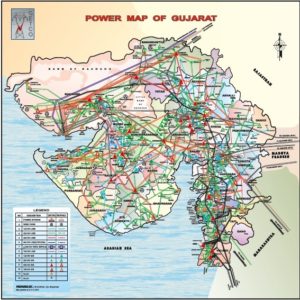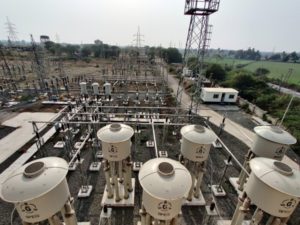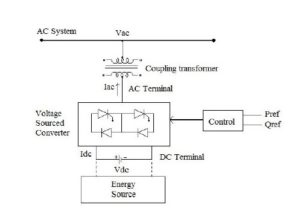 This case study, authored by Amar Arsiwala, explores the impact of the installation of Static Synchronous Compensator technology at the existing 220kV substation located in Timbdi, Gujarat. The STATCOM solution has facilitated GETCO’s objective to mitigate voltage variation, thereby supporting industrial industry capacity in network area, as well as allowing for smooth integration of renewable energy into the grid. By extension, these outcomes are paving the way for economic and social improvements in the Saurashtra region.
This case study, authored by Amar Arsiwala, explores the impact of the installation of Static Synchronous Compensator technology at the existing 220kV substation located in Timbdi, Gujarat. The STATCOM solution has facilitated GETCO’s objective to mitigate voltage variation, thereby supporting industrial industry capacity in network area, as well as allowing for smooth integration of renewable energy into the grid. By extension, these outcomes are paving the way for economic and social improvements in the Saurashtra region.
Grid operators today face constant challenges to ensure Power Quality parameters, namely voltage and frequency.
Introduction: The unprecedented blackouts of 2012 affected 21 of India’s 28 states, constituting the most severe, wide-spread power crisis till date. The blackouts were caused by consecutive grid disturbances affecting swathes of the Northern Regional Grid, effectively plunging one tenth of world’s population into darkness (Harris & Bajaj, 2012). The extensive outages became subject of an exhaustive Central Electricity Regulatory Commission (CERC) study. The report emphasised the need to tighten grid discipline measures, recommending technical solutions to mitigate future devastation, including the pressing need for a Dynamic Reactive Power Compensation System (CERC, 2012) .
 The 2012 disaster highlighted the severe limitations of India’s power infrastructure to adequately handle evolving demands from the emerging economy. Grid operators today face constant challenges to ensure Power Quality parameters, namely voltage and frequency, whilst mitigating frequent network faults, load switching and unstable renewable energy integration. Unpredictable active and reactive power demands add additional strain to the grid, as ever-changing linear and non-linear loads demand varying generating capacities, further impacting power quality. The blackout emphasised that our growing demands and dependence on energy infrastructure require modern and effective management of the grid, such as reactive power management to ensure grid stability.
The 2012 disaster highlighted the severe limitations of India’s power infrastructure to adequately handle evolving demands from the emerging economy. Grid operators today face constant challenges to ensure Power Quality parameters, namely voltage and frequency, whilst mitigating frequent network faults, load switching and unstable renewable energy integration. Unpredictable active and reactive power demands add additional strain to the grid, as ever-changing linear and non-linear loads demand varying generating capacities, further impacting power quality. The blackout emphasised that our growing demands and dependence on energy infrastructure require modern and effective management of the grid, such as reactive power management to ensure grid stability.
Whilst there is an abundant need to upgrade electricity grids across India, it remains the case that the majority of state utilities have been slow to adopt innovative technologies to strengthen this life-impacting energy infrastructure. Gujarat Energy Transmission Company Ltd (GETCO) is one of the few proactive utilities that sought to remedy key technical challenges through state-of-the-art grid technologies, being the first state utility in India to implement a static synchronous compensator (STATCOM) in March 2019.
STELMEC installed the STATCOM solution on the existing 220kV substation located in Timbdi, Gujarat, facilitating GETCO’s objective to mitigate voltage variation, and by extension, paving the way for economic and social improvements in the Saurashtra Region.
As the Timbdi substation is located over 60 km from the nearest substation, the network faced two critical challenges — frequent voltage drops during peak loads and high reactive power requirement.
The STATCOM Solution
The Timbdi 220/132/66/11kV substation has a total installed capacity of 450 MVA, serving the Gir Somnath district. As the Timbdi substation is located over 60 km from the nearest substation (DHOKADV2), the network faced two critical challenges. Firstly, there were frequent voltage drops during peak loads due to the length of the DHOKADV2- TIMBDI line. Secondly, there was a high reactive power requirement due to power consumed at a lower power factor. As such, before the installation of STATCOM, there was an unstable supply of power across the network causing interruptions to consumers’ ability to operate electrical equipment. Moreover, the 220kV Timbdi substation had no dynamic reactive power compensation equipment. Hence, at low load condition, high Bus voltage would occur due to overcompensation, and during heavy load condition, low Bus voltage would occur due to under compensation. In-depth studies indicated that for a 220kV bus voltage to be maintained at the Timbdi site, dynamic reactive power compensation was required in order to inject both capacitive and inductive reactive power as per the demands within the utility environment (Electric, 2014).
 The STATCOM based on cascaded H-bridge technology resembles in many respects a synchronous compensator but without the inertia. The basic electronic block of a STATCOM is the VSC, which converts an input dc voltage into a three-phase output voltage at fundamental frequency, with rapidly controllable amplitude and phase angle. This is achieved with the application of fast switchable state of the art IGBT based controllers. In addition to this, the controller has a coupling transformer and a dc capacitor. If the voltage measured by the system is lower than the reference voltage, the IGBT based controllers prompt the system to generate capacitive reactive power to increase the voltage. However, if the actual voltage is higher than the reference, the controller will rapidly generate inductive reactive power to decrease the voltage. Thereby, the system can maintain the magnitude of the bus voltage constant by controlling the magnitude and/or phase shift of the VSC output voltage. Furthermore, STATCOM functions with a very limited need for harmonic filters, contributing to a small physical footprint (Mondal, et al., 2014).
The STATCOM based on cascaded H-bridge technology resembles in many respects a synchronous compensator but without the inertia. The basic electronic block of a STATCOM is the VSC, which converts an input dc voltage into a three-phase output voltage at fundamental frequency, with rapidly controllable amplitude and phase angle. This is achieved with the application of fast switchable state of the art IGBT based controllers. In addition to this, the controller has a coupling transformer and a dc capacitor. If the voltage measured by the system is lower than the reference voltage, the IGBT based controllers prompt the system to generate capacitive reactive power to increase the voltage. However, if the actual voltage is higher than the reference, the controller will rapidly generate inductive reactive power to decrease the voltage. Thereby, the system can maintain the magnitude of the bus voltage constant by controlling the magnitude and/or phase shift of the VSC output voltage. Furthermore, STATCOM functions with a very limited need for harmonic filters, contributing to a small physical footprint (Mondal, et al., 2014).
Conventional management methods are both less responsive and less cost effective.
The Conventional Approach:  Undoubtedly, the installation of STATCOM at the Timbdi Site provides a higher standard of operating capacity for the provision of high power quality in the Saurashtra Region compared to conventional reactive power management. Traditionally, reactive power demands are managed by either capacitor banks or a combination of capacitors and reactors. This conventional approach to grid management is becoming increasingly limited in its ability to sustain the evolving requirements that India’s emerging economy demands from the existing energy infrastructure.
Undoubtedly, the installation of STATCOM at the Timbdi Site provides a higher standard of operating capacity for the provision of high power quality in the Saurashtra Region compared to conventional reactive power management. Traditionally, reactive power demands are managed by either capacitor banks or a combination of capacitors and reactors. This conventional approach to grid management is becoming increasingly limited in its ability to sustain the evolving requirements that India’s emerging economy demands from the existing energy infrastructure.
Conventional management methods, under which an installation needs sufficient capacitor and reactor capabilities, are both less responsive and cost effective, impacting the grid stability and power quality for the service region. Such installations require manual or semi-automatic switching operations that reduce system response time in managing reactive power requirements within the grid. In addition, operation and maintenance costs are high due losses, coupled with the need for frequent replacements and repairs. These operating costs are also added to by the large operating space requirements that are increasingly more expensive particularly in urban areas. Finally, conventional solutions generate high harmonics that require additional filters to be installed (Suntio & Messo, 2018).
The Timbdi 220kV site is now capable of maintaining a suitable voltage profile via STATCOM technology, thereby supporting Gujarat’s industrial sector.
Supporting Industrial Ambition: The STATCOM-enabled installation in Timbdi services the Saurashtra region, feeding residential vicinities as well as various industries requiring large non-linear and cyclic loads. Industrial development and investment in Gujarat have long stood as an economic pillar of the state’s development, with the increases in the proportion of industrial-based revenue from the State utility indicative of this. In Gujarat, industrial customers grew from 29 per cent of total state consumption in 1999 to 47 per cent in 2014, accounting for 62 per cent of annual revenue that year (Dubash, 2018). As continuous process industries including cement and textile plants, heavy chemical and pharmaceuticals, require stable power supply to avoid losses in output, upkeep of grid discipline through technology is imperative.
As such, given that the Timbdi 220kV site is capable of maintaining a suitable voltage profile via STATCOM technology, the installation assists in supporting Gujarat’s industrial sector. By providing businesses optimal power operating conditions for greater productivity, this industry-adaptable technological solution caters not only for existing key players including Ambuja Cement, Indian Rayon and Gujarat Heavy Chemicals but also creates a fertile environment to attract future development as industrial demands evolve – all of which supports a healthy customer base for GETCO.
Building for a Greener Tomorrow: In addition to industrial utility, STATCOM technology competently resolves the challenges traditionally faced when integrating renewable generation into the grid, thus incentivising green energy investment in the Timbdi network. This is particularly relevant coupled with the geographical context of Gujarat, which has vast potential for solar and wind generation along the largely barren, non-arable 1700km coastline (Dubash, 2018). Gujarat is ideally positioned to become a hub for renewable power generation with guaranteed stable integration facilitated via the Timbdi substation. Domestic policies including the national 2022 energy targets along with international initiatives such as the Indo-French International Solar Alliance established in 2015, are indicative of the ever-increasing importance of renewable energy. The STATCOM solution provides the technical bridge to enable smooth integration of solar and wind energy into the grid.
It is evident that the implementation of STATCOM technology at the Timbdi 220 kV substation has supported positive social outcomes in Gujarat.
A Brighter Future for All
Finally, it is important to highlight the advantageous impact that efficient energy provision has on social development and the lives of those in the network region. Beyond the direct employment that the Timbdi site creates, the guaranteed supply of stable power that the STATCOM system provides will likely, over time, enhance labour and health outcomes for the economically, and thus often socially, disadvantaged. Increases in household income for low or semi-skilled workers – usually women (Dinkelman, 2011) – employed in occupations that require the use of electricity has been found to directly correlate with improved health outcomes (Burlando, 2011). Access to electricity is a key development priority for the World Bank, impacting not only health and economic wellbeing but also education, food security, gender equality and poverty reduction outcomes (Bank, 2018). With a direct effect on employment elasticity, increased economic output through the provision of stable electricity has a flow on effect on livelihoods and thus lives.
In summary, it is evident that the implementation of STATCOM technology at the Timbdi 220 kV substation has provided stability for existing industries; created a fertile environment for future industry; and allowed for penetration of renewable energy, all of which cumulatively foster economic development and thus help support positive social outcomes in Gujarat. The benefits of robust energy infrastructure are clear, and we hope that in future our private and public partners will join us in taking up the call to create a brighter, stronger India for all.
About the author: Amar Arsiwala is Director, STELMEC Ltd
Bibliography
- Bank, T. W., 2018. Access to Energy is at the Heart of Development. [Online] Available at: https://www.worldbank.org/ [Accessed on May 26, 2020].
- Burlando, A., 2011. The Impact of Electricity on Work and Health: Evidence from a Blackout in Zanzibar. SSRN Electronic Journal.
- CERC, 2012. Report on grid distrubance on 30th July 2012 and grid distrubance on 31st July 2012, Delhi : CERC .
- Dinkelman, T., 2011. The Effects of Rural Electrification on Employment: New Evidence from South Africa. American Economic Review , 101(7).
- Dubash, N., 2018. Mapping Power: The Political Economy of Electricity in India’s States. First Edition ed. Oxford: Oxford Univeristy Press .
- Electric, N., 2014. Project for±120MVAR STATCOM at existing 220kV TIMBDI substation – STATCOM System Study Report , s.l.: NR Electric.
- Harris, G. & Bajaj, V., 2012. The New York Times. [Online]
- Available at: https://www.nytimes.com/2012/08/02/world/asia/power-restored-after-india-blackout.html [Accessed May 26, 2020].
- Mondal, D., Chakrabarti, A. & Sengupta, A., 2014. Power System Small Signal Stability Analysis and Control. 1st Edition ed. Oxford : Elsevier Inc. .
- Suntio, T. & Messo, T., 2018. Power Electronics in Renewable Energy Systems. Basel : Tampere University of Technology.


